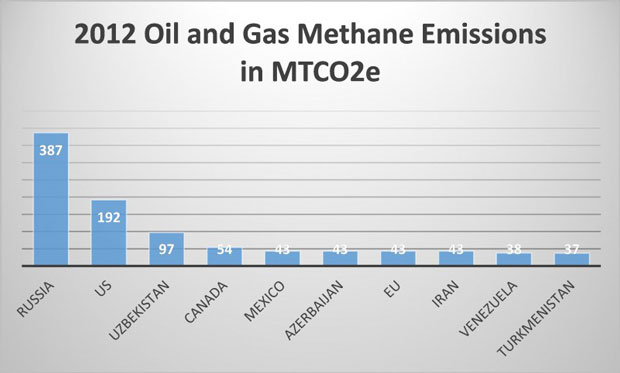
.jpg)
Yogi Schulz
Published: March 16th, 2016
Prime Minister Justin Trudeau and President Barack Obama issued a joint statement on 10 March 2016 that included a commitment to reduce greenhouse gases by:
- Reducing methane emissions by 40-45 percent below 2012 levels by 2025 from the oil and gas sector.
- Exploring new opportunities for additional methane reductions.
As illustrated in the below graph of the top 10 methane emitting countries, the United States ranks 2nd and Canada ranks 4th in methane emission volumes produced by each country’s oil and gas industry. Both countries emit considerably less methane than Russia. Hopefully leadership from the United States and Canada on this issue will finally encourage other countries to take similar action. The risk of disadvantaging a nation competitively has always been a stumbling block preventing actionable results.
In the past, Canada’s oil and gas industry has pointed to the low Canadian share of global methane emissions, technical difficulties, and added costs that undermine competitiveness as reasons for not taking more action. This time around, action will be more difficult to avoid because of the 2015 Paris Climate Conference commitments and the joint United States and Canada announcement.
Beyond deliberate emissions and flaring, the next most important sources of greenhouse gas emissions are fugitive emissions. In the Global Methane Initiative estimates for Canada, fugitive emissions are almost as much as the deliberate emissions.
Here are some modest actions that Alberta oil and gas producers can consider to reduce emissions and flaring. These ideas have already produced tangible results for some producers.

Replace emissions with flaring
Whenever a methane emission volume is replaced by a flared volume, the associated greenhouse gas reduction is 95%.
There are still producing locations in Alberta where small flare stacks can be installed at modest cost. Many dense producing areas exist in Alberta where volumes, that are currently emitted, can be gathered and flared at modest cost. These areas are shown in the AER ST60B: Upstream Petroleum Industry Flaring and Venting Report (page 18). Reducing the minimum volume and cost of flare stacks is another opportunity to be explored.
Replace emissions and flaring with consumption
Whenever an emitted or flared methane volume is consumed instead, the associated greenhouse gas reduction is 100%. Many locations exist in Alberta where these volumes can be gathered and consumed at modest cost. See ST60B (page 9), for a list of high-flaring volume gas plants.
In Alberta, vast rural gas networks, operated by 81 natural gas co-operatives consume methane. In 2008, theCounty of Vermilion River won the Emerald Award for Climate Change for its gathering and consumer consumption of methane that would otherwise be emitted or flared. There are more opportunities to supply currently emitted or flared methane volumes to natural gas co-operatives for consumption.
Reduce fugitive emissions
Whenever a fugitive methane emission is avoided, the associated greenhouse gas reduction is 100%. There are tens of thousands of pieces of production equipment in Alberta where these fugitive emissions can be avoided.
The top five sources of production equipment fugitive emissions in the United States in 2013 were pneumatic controllers, tanks, equipment leaks, liquids unloading and gas-assisted glycol pumps. Here’s a list of recommended technical solutions for these fugitive emissions.
For a list of the top 25 Alberta oil and gas producers with their deliberate emission and flaring volumes see ST60B(page 21). Every producer can materially reduce their ranking on this list with modest actions.
Read more about the World Bank initiative, Zero Routine Flaring.
Read more insightful analysis from Yogi here



